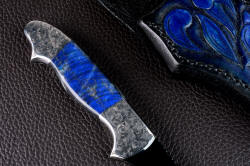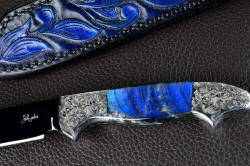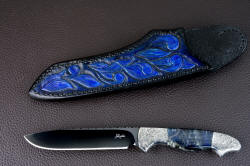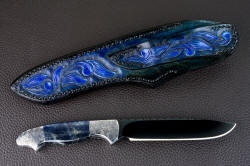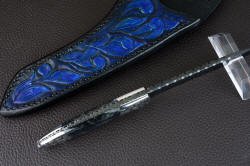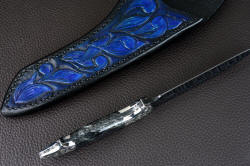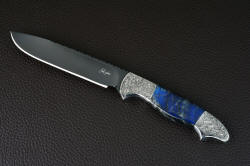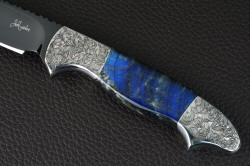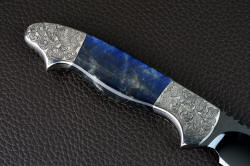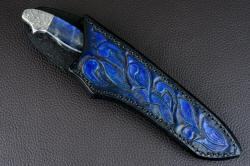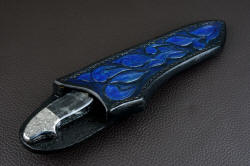Carina
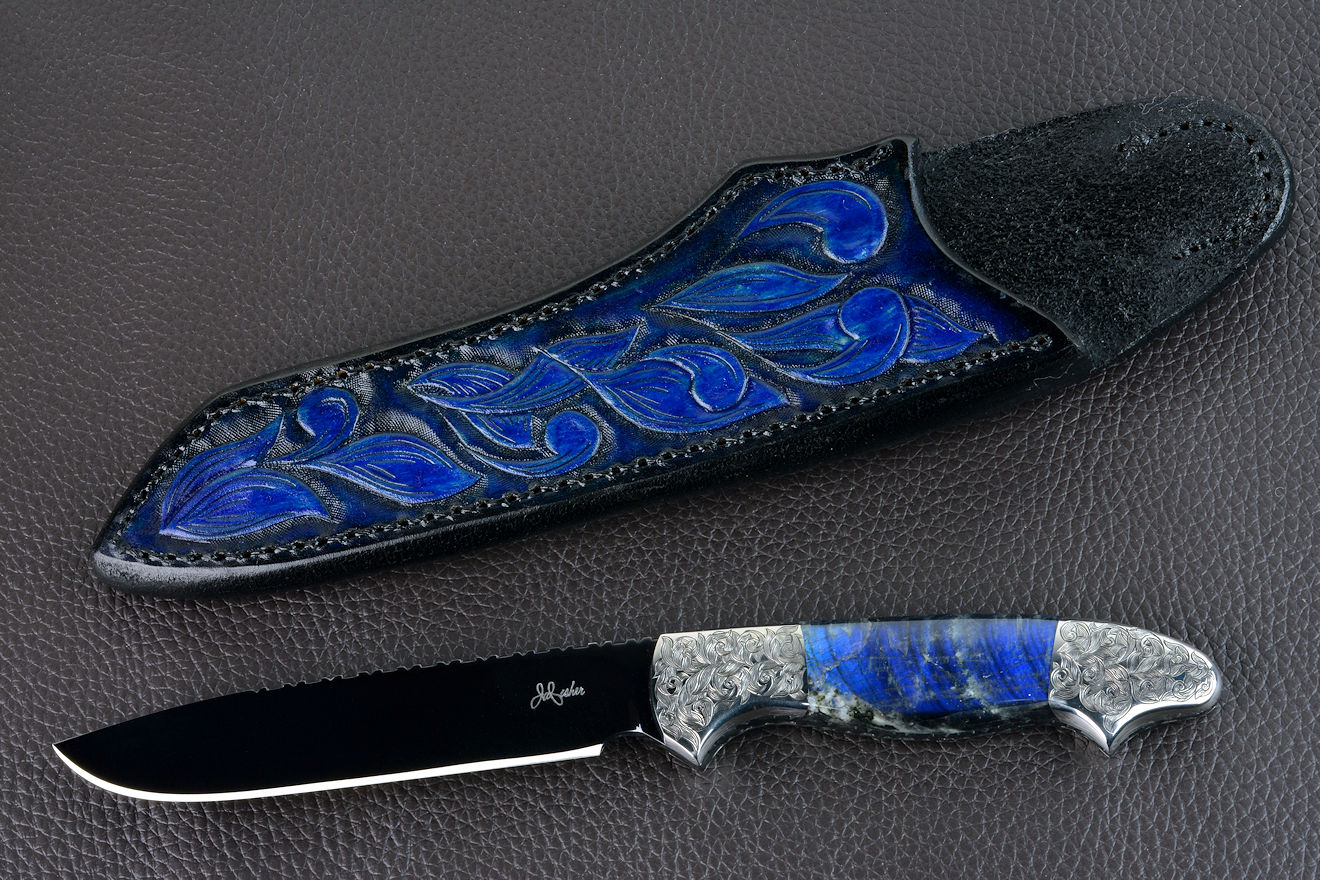
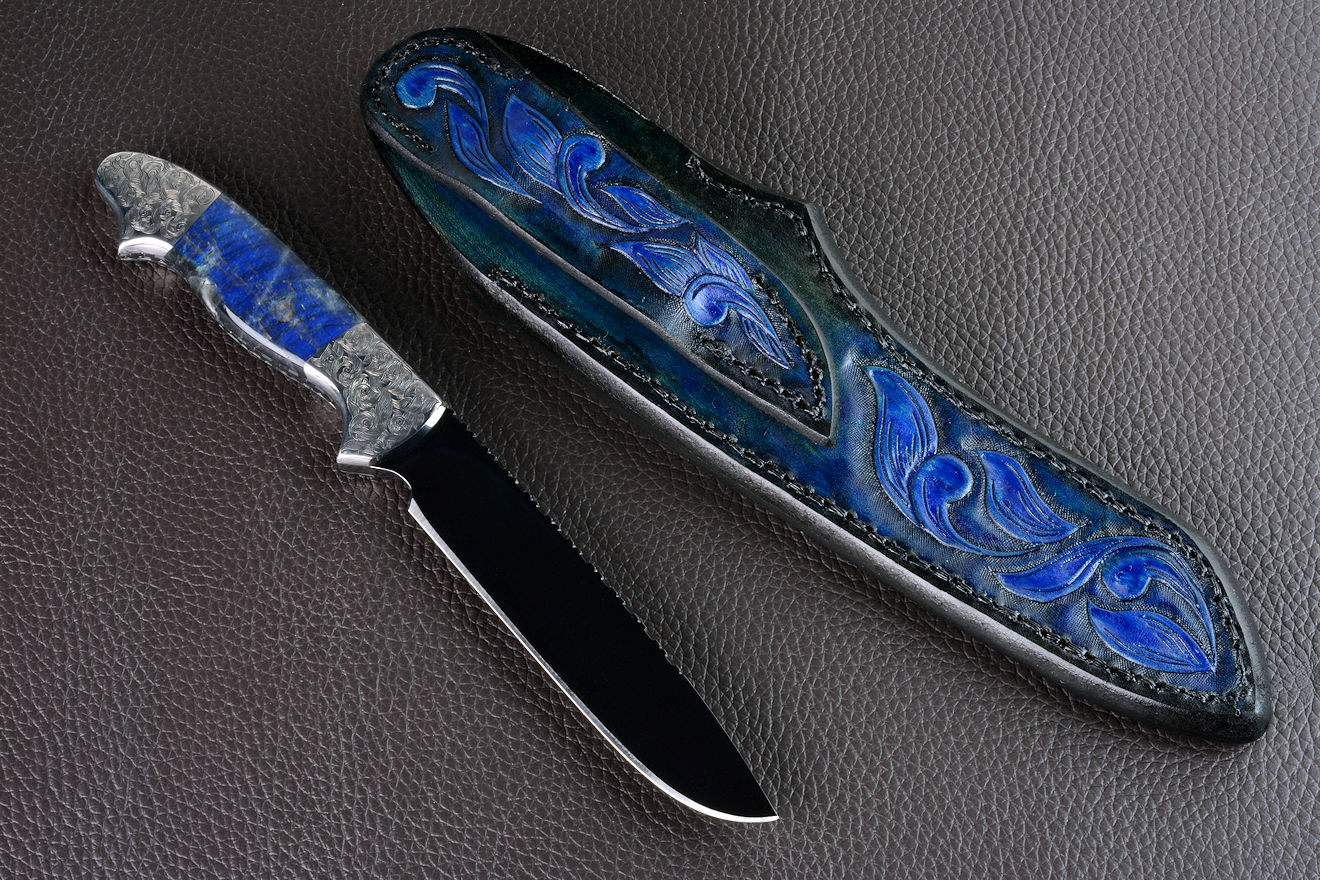
"Carina"
- Size: Length overall: 8.75" (22.2 cm), Blade Length:
4.5" (11.4 cm), Thickness: .184" (4.7 mm)
- Weight: Knife: 6.0 oz. (170 grams) Sheath: 3.7 oz. (105 grams)
- Blade: O1 high carbon tungsten-vanadium tool
steel, mirror polished, hot-blued, hardened and tempered using
cryogenic process to 59HRC
- Bolsters, Fittings: 304 Austenitic Stainless Steel, hand-engraved
- Handle: Labradorite gemstone, Labrador, Canada,
Tabor Island
- Sheath: Hand-carved leather shoulder, hand-dyed
- Knife: The Carina is named for a constellation
in the southern sky, and the Latin word for the keel of a ship. It
was a navigation point for the southern peoples, notably the Maori
who called it "first light," due to its prominence. I tried to honor
this name and idea in a simple drop point knife design with a splendid and
unique presentation. The knife is noticeable in a jet black, shiny,
mirror polished blade of O1 high carbon tungsten-vanadium tool
steel. I took this blade to its maximum as I heat treated and
quenched and aged this steel with shallow cryogenic process, with
deep cryogenic cycling between multiple tempers. This results in an
extremely wear-resistant and tough blade, an improvement of 400
percent better wear resistance than a conventionally heat treated blade
in the same steel, with even higher toughness! This is just about the
best this steel can be, and it's ground with a smaller contact wheel
for a tight radius. What this means is that though the steel behind
the cutting edge is very thin, the spine is significantly thick for
this size of knife, providing great strength. The drop point aids in
easy sheathing, and the blade is long and elegant in this size. I
fully fileworked the blade with a small regimented pattern, and the
tang is fully tapered for balance. I bolstered the knife with
zero-care 304 stainless steel, a high nickel, high chromium tough
austenitic stainless that is used to make stainless nuts, bolts, and
fasteners. The bolsters are rounded, contoured and mirror polished
and then I engraved them with a very tight and fine design of leaves
and scroll. The bolsters are dovetailed and bed a pair of unusual
handle scales. This is labradorite, a feldspar with good hardness,
and some unique and striking characteristics. It is actually a dark
stone, and changes dramatically in various lighting, angles of
light, and angles of viewing. The unique play of light is like
nothing else on our planet, and so has its own scientific term
called labradorescence. This is a metallic, multi-colored,
prismatic play of glinting light with vibrant spectral hues, only
visible as the stone is moved through specific positions. In
the photo set, I tried to angle the lighting, camera, and knife so that you
could see just what the result is, but like many plays of light in
gemstone, this is not fully visible in the camera. I found that in
photographing this property, the light itself would confuse the
camera's interpretive software, and flare the image, even though it
wasn't bright, a strange artifact of the intense light play at
various angles. The color of the gemstone varies between a gray
transparent hue, to a darker cloudy crystal, to bright and intense
royal blue with hints of green and even reddish tints! This is a
fascinating stone, and one I get asked about a lot. The really good
labradorite is getting harder to find, and much of it is too small
for knife handle scales in higher quality. The schiller or
iridescence is caused by a grid-like lamellar structure, and
repeated twinning of crystal forms. There are also minor inclusions
of magnetite and you'll see some metallic-looking polish in those
areas along the tang. This stone has to be carefully oriented when
cutting, and I took considerable time and care to work up my slabs
from rough to get the most material at the brightest angles. The
stone has plenty of surface seams that look like fractures, but are
solid and secure. While labradorite can be a bit brittle, it's also
fairly hard, at 6.5 on the MOHS scale, so in a small knife, it's
right at home. With the black blade, this is a striking and unique
knife, and the hand-engraving adds a lot to the intricacy of the
bold piece. The balance point is right at the forefinger position in
forward grip, and the three and a half finger handle is light and
comfortable in the hand.
- Sheath: The sheath for this Carina had to match
the knife well, which was a bit of a challenge. I designed the same
leaf and scroll pattern I did in the engraving for the sheath, and hand-carved and tooled
it in 9-10 oz. leather shoulder. I then took considerable time to
hand-dye the sheath pattern, trying to reflect the iridescent blues
in the handle with a rich royal blue color wash against a black
background. The sheath is hand-stitched with polyester, tooled front
and back, and sealed with acrylic for longevity.
- A unique work of art, great in any collection.
Thanks, K. S.!
Hi Jay.
I received the Carina yesterday, and thank you! It is breathtakingly beautiful. An amazing work of art, thank you.
Cheers,
K.
Please click on thumbnail knife photos
